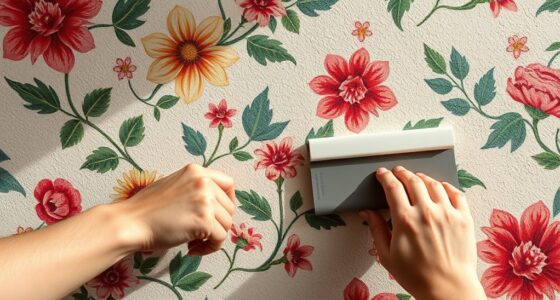Historic wallpaper styles like toile, chinoiserie, and Arts & Crafts combine rich cultural influences and craftsmanship to create timeless interiors. Toile features detailed narrative scenes inspired by pastoral and classical themes, often in subdued colors. Chinoiserie showcases exotic Asian motifs like pagodas, dragons, and gardens, reflecting cultural exchange. The Arts & Crafts movement emphasizes handcrafted patterns inspired by nature and simple forms. If you want to explore how these styles evolved and how to incorporate them, there’s more to discover below.
Key Takeaways
- Toile wallpaper originated in 18th-century France, featuring narrative scenes with subdued colors and detailed craftsmanship.
- Chinoiserie reflects Asian-inspired motifs like pagodas and dragons, highlighting exotic elegance and cultural symbolism.
- Arts & Crafts wallpaper emphasizes handcrafted techniques, natural motifs, and a rejection of mass production for authentic, textured designs.
- Traditional production methods included block printing and hand painting on natural fibers, evolving to digital printing with synthetic materials.
- These styles often incorporate botanical, mythological, and historical themes, reflecting societal values, cultural exchanges, and artistic innovation.
The Origins and Development of Toile Wallpaper
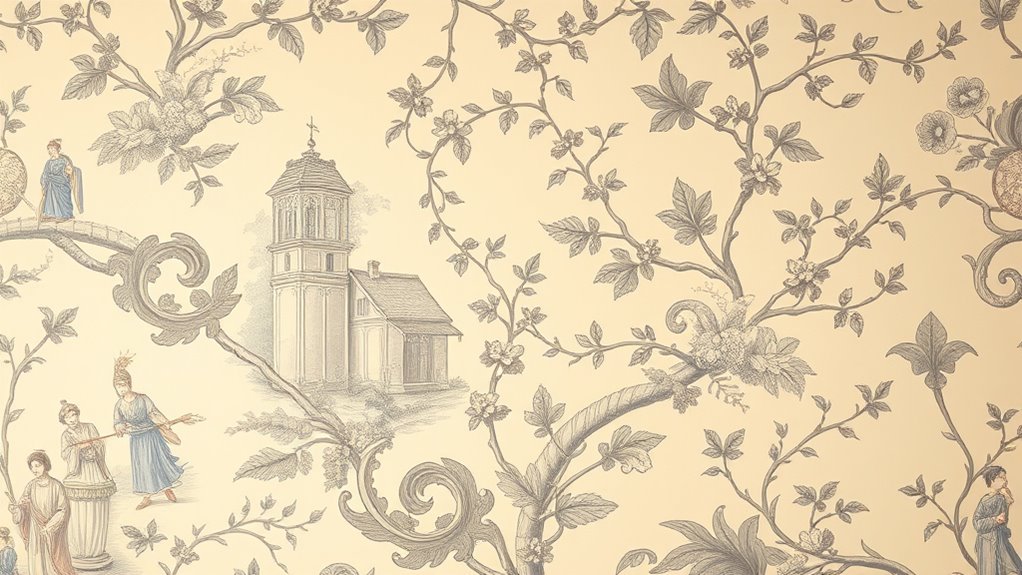
Have you ever wondered where toile wallpaper originated? It traces back to late 18th-century France, where wallpaper manufacturing evolved to include intricate, narrative scenes. Artists crafted detailed designs inspired by pastoral life, historical events, and classical themes, which became the hallmark of toile. When you select toile wallpaper, you’re choosing a style rooted in tradition and craftsmanship. The color palette choices are typically subdued, using soft blues, warm browns, and gentle grays, which enhance the detailed illustrations without overwhelming the eye. This careful balance of design and color made toile popular among the European aristocracy and middle classes alike. Over time, its development reflected advancements in wallpaper manufacturing, allowing for more precise printing techniques that preserved the delicate artistry of these timeless patterns. Additionally, embracing creative practice in design and craftsmanship has helped maintain the enduring appeal of toile styles through the ages. Furthermore, innovations in printing techniques have allowed artisans to produce more detailed and durable wallpapers, ensuring their longevity and continued popularity.
Chinoiserie: An Exotic Artistic Expression

Ever wonder how Chinoiserie became a symbol of exotic elegance in Western interiors? It’s because this style captures a sense of mystery and luxury through intricate designs inspired by Asian art. Originally, artists and designers used Chinoiserie to showcase cultural symbolism, blending traditional motifs with Western tastes. You’ll notice the rich details on luxury textiles and wallpapers, depicting pagodas, dragons, and delicate landscapes. These elements evoke a sense of adventure and opulence, making your space feel both refined and worldly. Chinoiserie’s appeal lies in its ability to bring an exotic, almost magical atmosphere into your home, all while celebrating an appreciation for distant cultures. Its timeless charm continues to influence interior design, offering a unique way to add elegance and cultural depth. Additionally, the popularity of Chinoiserie has been supported by the availability of self watering plant pots, which often feature similar intricate and exotic motifs that complement this style. Incorporating cultural symbolism into your decor can further enhance the sense of sophistication associated with Chinoiserie. Moreover, understanding the exotic appeal of this style can help you create a space that feels both luxurious and culturally rich. In fact, the use of decorative motifs like dragons and pagodas often reflects historical trade routes and cultural exchanges that have enriched Western design traditions.
The Arts & Crafts Movement and Its Impact on Wallpaper Design

The Arts & Crafts Movement shifted wallpaper design toward handcrafted techniques and natural motifs, emphasizing quality over mass production. This movement prioritized artisanal craftsmanship as a core value, leading to the creation of unique, handcrafted patterns that celebrated individual skill and artistry. You’ll notice simpler, functional patterns inspired by nature that highlight craftsmanship and authenticity. This approach transformed wallpaper from mere decoration into a reflection of honest, artisanal values. Incorporating vintage or distressed furniture into interior schemes further enhances the authentic, handcrafted aesthetic championed by the movement. Additionally, the movement’s emphasis on natural materials ensured that wallpapers often featured organic textures and eco-friendly components, reinforcing its commitment to sustainability and genuine craftsmanship. Such designs often feature patterns derived from botanical illustrations, which underscore the movement’s deep connection to nature and craftsmanship.
Emphasis on Handcrafted Techniques
While mass-produced wallpaper became popular during the late 19th century, the Arts & Crafts Movement championed a return to handcrafted techniques that emphasized quality and artistry. Artists and craftsmen prioritized traditional methods over industrial processes, often working by hand to create unique designs. Even as digital printing emerged, enabling rapid reproduction, artisans favored hand-blocked methods to maintain authenticity. They also chose natural dyes over synthetic dyes, valuing their richer, more subtle hues. This focus on craftsmanship meant that each wallpaper piece was a testament to skill and attention to detail. The movement celebrated imperfections and individual expression, encouraging a departure from uniformity and mass production. Additionally, authenticity in design was a core principle, ensuring that each piece conveyed the unique character of handcrafted artistry. The emphasis on traditional techniques further reinforced the movement’s dedication to preserving artisanal skills in wallpaper production. Furthermore, the movement’s emphasis on sustainable practices reflected a commitment to environmentally conscious craftsmanship. As a result, collecting handcrafted wallpaper became a way for enthusiasts to appreciate artisanal craftsmanship and support sustainable, ethical production methods. Your appreciation for handcrafted wallpaper stems from this desire for artistry and distinctiveness rooted in the movement’s philosophy.
Nature-Inspired Motifs
Nature-inspired motifs became a defining feature of Arts & Crafts wallpaper, reflecting the movement’s deep appreciation for the natural world. You’ll notice botanical motifs, such as stylized leaves, flowers, and vines, which emphasize craftsmanship and harmony with nature. Animal illustrations also play a significant role, often depicted in a realistic yet decorative manner. These designs move away from industrial repetition, instead highlighting handcrafted details and individual expression. You might see intricate patterns of birds, insects, or woodland creatures, all integrated seamlessly into the overall design. By focusing on natural forms, Arts & Crafts wallpaper celebrates the beauty of the outdoors and encourages a connection to nature within your living space. This approach underscores a shift toward authenticity and artistic integrity in interior decoration. Additionally, the use of natural motifs reinforces the movement’s emphasis on organic beauty and handcrafted artistry. The emphasis on handcrafted details aligns with the movement’s core values of craftsmanship and individual expression, making each wallpaper unique and meaningful. Furthermore, incorporating sustainable materials was also a key aspect of their philosophy, promoting environmentally conscious design choices. Engaging with biodiversity in design helped artisans reflect the richness of natural ecosystems.
Simplicity and Functionality
During the Arts & Crafts movement, designers prioritized simplicity and functionality over ornate decoration, transforming wallpaper into a practical yet aesthetically pleasing element of interior spaces. You’ll notice a shift toward minimalist patterns that emphasize clean lines and natural forms, reflecting the movement’s appreciation for craftsmanship. Bold color palettes became common, adding visual impact without overcrowding the design. This approach encourages you to focus on the quality of materials and the harmony of the overall space. Wallpapers often feature straightforward motifs inspired by nature, emphasizing utility and beauty. With less ornamentation, you gain a sense of calm and order in your environment. The emphasis on craftsmanship and quality materials helps create timeless interiors that blend beauty with practicality.
Key Characteristics of Classic Toile Patterns
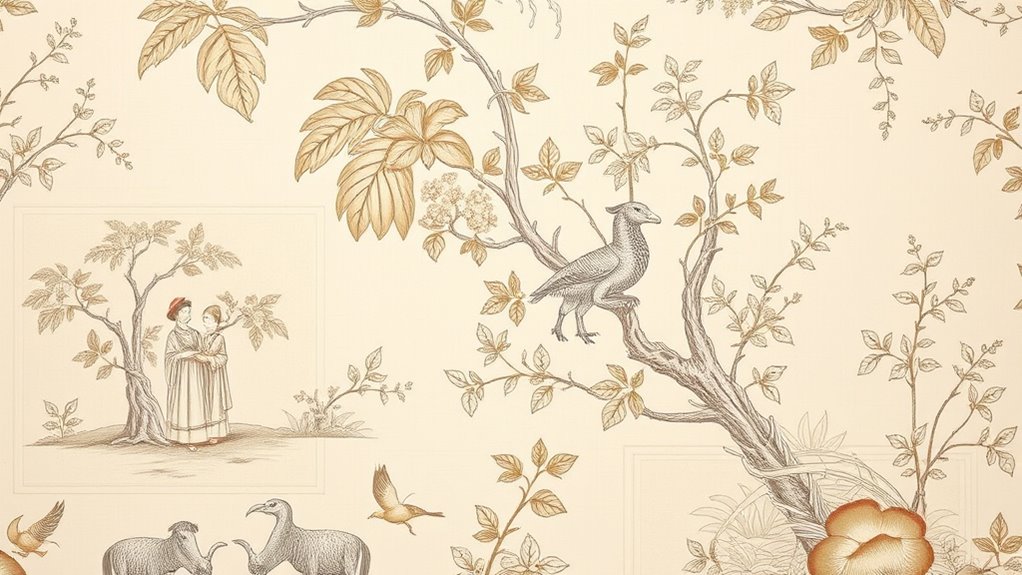
Classic toile patterns are characterized by their detailed, monochromatic scenes that often depict pastoral landscapes, historical events, or mythological figures. You’ll notice the intricate scenes are usually set against a plain background, emphasizing storytelling through imagery. Botanical motifs are commonly woven into the designs, adding a touch of nature and elegance. The color palettes tend to be restrained, featuring shades like black and white, indigo, or soft earth tones, which enhance the timeless quality of the patterns. These wallpapers evoke a sense of nostalgia and sophistication, making them ideal for creating a refined, historical ambiance. The combination of detailed imagery and subtle hues defines the classic toile style, making it a distinctive and enduring choice in interior design. Incorporating design principles can further enhance the aesthetic appeal of these patterns in an interior space.
The Influence of Asian Art on Chinoiserie Styles
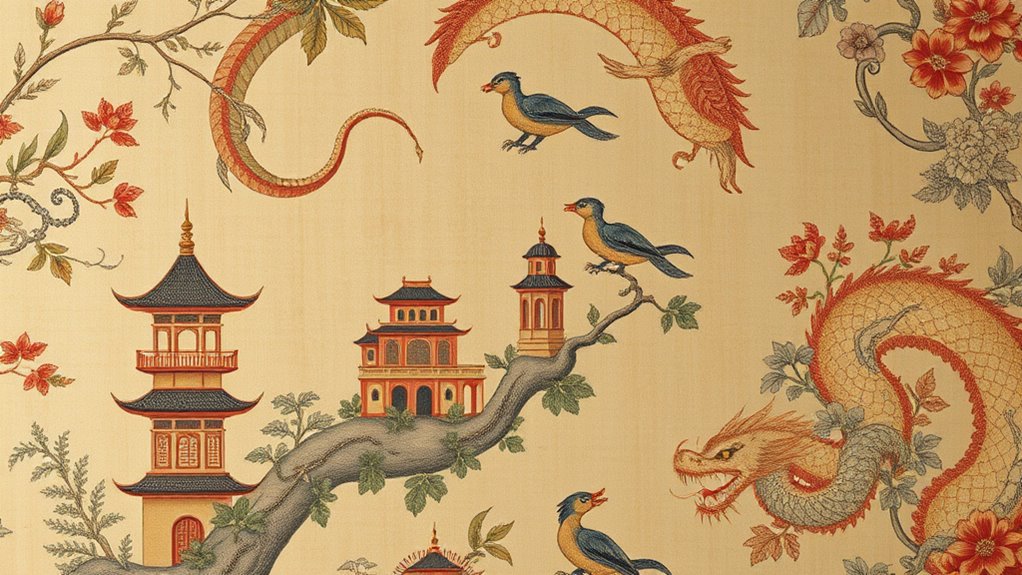
The influence of Asian art on Chinoiserie styles is evident in the intricate motifs and exotic themes that define this decorative movement. You’ll notice how Asian textiles inspired the detailed patterns and lush imagery, capturing the essence of distant lands. Decorative motifs such as pagodas, dragons, and cherry blossoms frequently appear, creating a sense of mystery and adventure. These elements reflect a fascination with Asian culture, blending it into European design. Chinoiserie wallpaper often features scenes of tranquil gardens, bustling markets, and mythical creatures, all inspired by Asian artistry. This style celebrates the beauty and complexity of Asian textiles and motifs, bringing an air of elegance and curiosity into your space. It’s a perfect way to add historical depth and cultural richness to your decor. Additionally, the use of decorative motifs helps to evoke a sense of timeless artistry and craftsmanship. Exploring the cultural influences behind these designs can deepen appreciation for their historical significance and artistic heritage. Furthermore, the incorporation of Asian artistic techniques enhances the richness and authenticity of these decorative elements.
Techniques and Materials Used in Historic Wallpaper Production
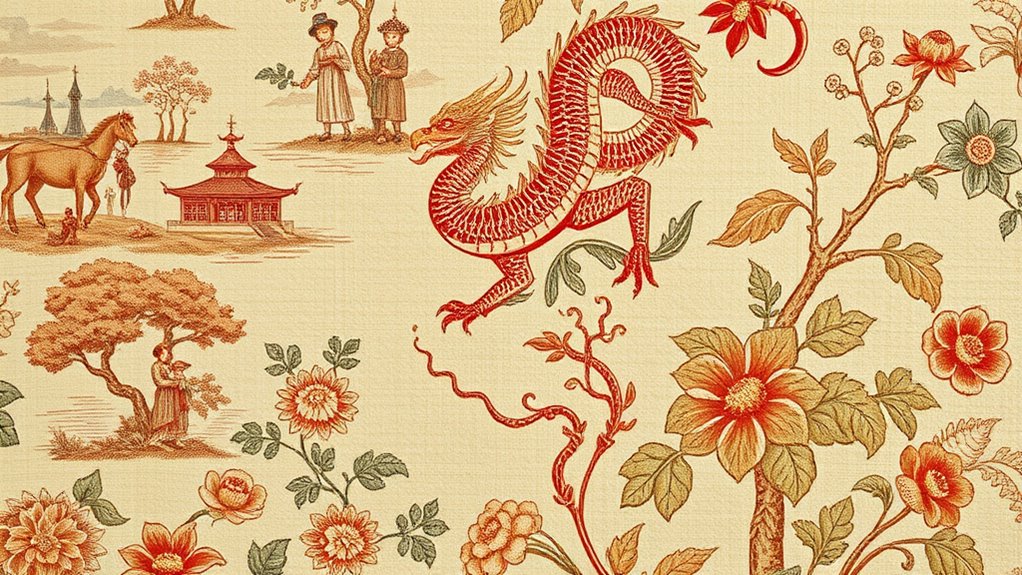
Historic wallpaper production relies on a variety of techniques and materials that reflect the craftsmanship and technological advances of their time. Traditional methods include block printing and hand-painted designs, while modern techniques incorporate digital printing for intricate, fast reproductions. Materials ranged from natural fibers like linen and silk to early synthetic materials, which offered durability and new textures.
| Technique | Material |
|---|---|
| Block printing | Linen, silk, paper |
| Hand painting | Natural fibers, wallpapers |
| Digital printing | Synthetic materials, vinyl |
This table illustrates how production methods evolved, blending old craftsmanship with innovative tools. Today, synthetic materials and digital printing enable detailed, vibrant designs, echoing historic styles while embracing modern technology.
How Societal Values Shaped Arts & Crafts Wallpaper Aesthetics
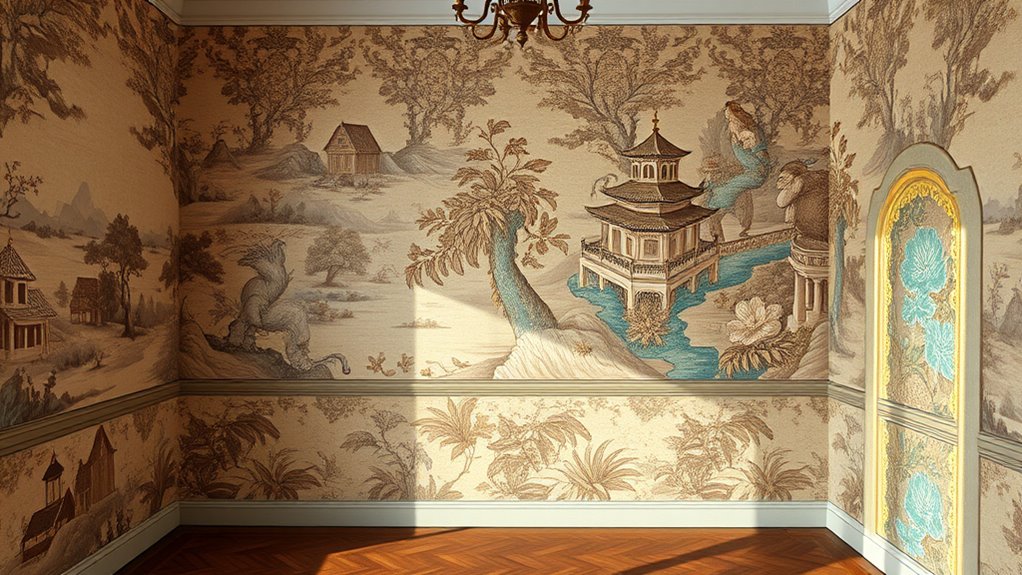
You notice how Arts & Crafts wallpaper emphasizes handcrafted details and simple designs. This reflects society’s shift toward valuing authenticity and practicality over ornate decoration. By embracing these qualities, the style aligns with a broader desire for honest, functional beauty in everyday life.
Emphasis on Handcrafted Detailing
As societal values shifted toward valuing craftsmanship and individuality, the Arts & Crafts movement emphasized handcrafted detailing in wallpaper design. You’ll notice rich textures and meticulous artistry that highlight the skill involved. This focus led to the use of botanical patterns inspired by nature, showcasing detailed leaves and flowers. Geometric motifs also became popular, emphasizing precision and harmony. Handcrafted techniques meant wallpapers were often produced with visible brushstrokes and textured finishes, making each piece unique. The movement rejected mass production, favoring artisanal quality. You might find wallpapers featuring:
- Intricate botanical patterns
- Bold, handcrafted geometric motifs
- Textured surfaces highlighting craftsmanship
- Unique, non-repetitive designs
- Use of natural materials and finishes
This approach celebrates individual artistry and the beauty of handcrafted detail.
Embracing Simplicity and Function
The Arts & Crafts movement shifted focus toward simplicity and practicality, reflecting society’s growing desire for honest, functional design. You’ll notice this change in wallpaper styles, where botanical patterns become more straightforward, emphasizing natural beauty without excess ornamentation. Geometric designs also gain popularity, highlighting clean lines and symmetry that prioritize utility and order. This aesthetic shift aligns with societal values that favor durability and honest craftsmanship over elaborate decoration. You’re encouraged to appreciate how these patterns move away from ornate, overly detailed motifs, embracing minimalism and straightforwardness. By doing so, wallpaper becomes not just decorative but also a reflection of a desire for authenticity, practicality, and a connection to nature—core principles shaping Arts & Crafts design.
Notable Artists and Designers Behind These Styles
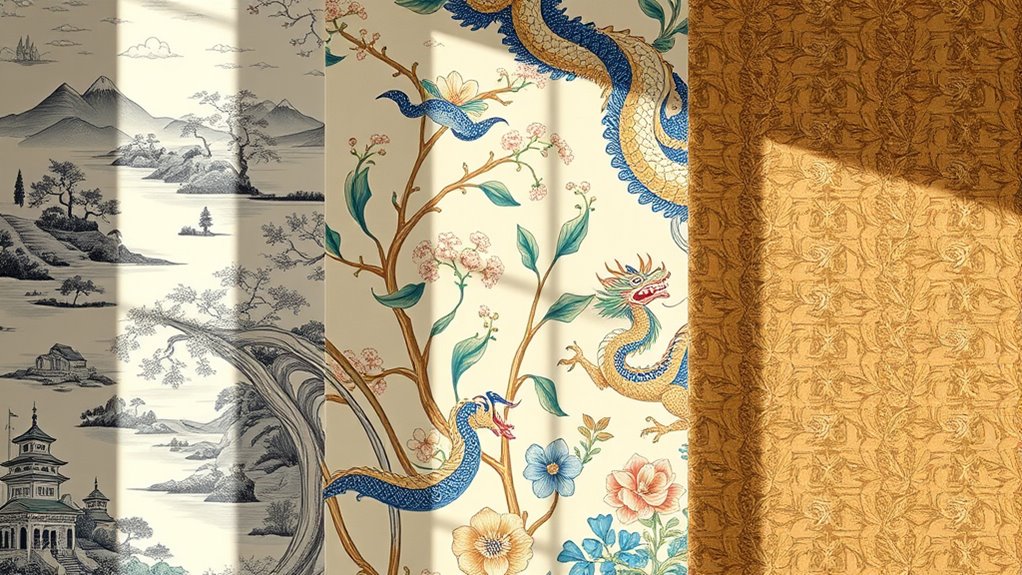
Many influential artists and designers have shaped the evolution of historic wallpaper styles, leaving a lasting impact through their innovative patterns and artistic visions. Their work often features vintage color palettes that evoke nostalgia and elegance. You’ll find their influence in the intricate toile scenes, delicate chinoiserie motifs, and handcrafted Arts & Crafts designs. To bring these styles into your space, consider wallpaper installation tips like preparing your walls properly and choosing the right adhesive. Recognizing the creators behind these styles enriches your appreciation and helps you select authentic reproductions. Here are some notable figures:
- Jean-Baptiste Huet (toile de Jouy)
- William Morris (Arts & Crafts)
- Christopher Dresser (Chinoiserie)
- Louis XV and XVI designers (French Rococo)
- Walter Crane (Arts & Crafts)
Modern Interpretations and Revivals of Historic Wallpapers

Today’s designers are reimagining historic wallpaper styles with fresh perspectives, blending vintage motifs with contemporary aesthetics. They often experiment with wallpaper color trends, opting for bold or muted palettes that suit modern spaces. Soft pastels or striking jewel tones can refresh classic designs like Toile or Chinoiserie, making them feel current. Interior lighting effects play a pivotal role in these revivals, enhancing patterns and highlighting textures to create dynamic visual interest. Subtle lighting can emphasize intricate details, while brighter illumination can make wallpapers pop. This approach allows you to adapt historic styles seamlessly into modern interiors, maintaining their charm while aligning with contemporary tastes. The result is wallpaper that feels both timeless and relevant, offering a fresh take on beloved classic patterns.
Tips for Incorporating Vintage Wallpaper Styles Into Contemporary Interiors

Incorporating vintage wallpaper styles into contemporary interiors begins with selecting patterns that complement your overall design aesthetic. Focus on wallpaper pattern variations that balance historic charm with modern simplicity. Your color palette choices should harmonize with existing decor, so opt for subdued hues or bold contrasts based on your preferred mood. To make a seamless integration, consider these tips:
Select vintage wallpaper patterns that blend historic charm with modern simplicity for seamless interior integration.
- Choose a feature wall with vintage wallpaper to add visual interest.
- Pair intricate patterns with minimal furniture to prevent clutter.
- Mix vintage wallpaper with modern textures for a balanced look.
- Use wallpaper borders or accents to highlight specific areas.
- Experiment with different wallpaper pattern variations to find the perfect fit.
Frequently Asked Questions
How Did Wallpaper Manufacturing Techniques Evolve During These Historic Periods?
During these historic periods, wallpaper manufacturing techniques evolved markedly through manufacturing innovations and pattern printing techniques. You’ll notice that stencil and block printing allowed for more intricate designs, while later developments like roller printing increased efficiency and detail. These advancements made wallpaper production faster, more affordable, and enabled detailed, repeatable patterns, reflecting the artistic trends of each era. This progression helped bring diverse, stylish wallpapers into homes worldwide.
What Symbolic Meanings Are Often Embedded in Historic Toile Patterns?
You’ll find that historic toile patterns often embed symbolic motifs representing cultural symbolism or social ideals. For example, nearly 60% of traditional toile designs feature pastoral scenes or mythological figures, reflecting ideals of harmony and innocence. These patterns serve as visual storytelling, conveying messages of wealth, virtue, or cultural identity. By incorporating these motifs, you connect with history’s deeper meanings, making your space both stylish and rich in symbolic significance.
How Did Societal Changes Influence the Popularity of Chinoiserie and Arts & Crafts Styles?
Societal changes, like increased cultural exchange and a desire for artistic innovation, drove the popularity of chinoiserie and Arts & Crafts styles. You see this in how chinoiserie reflects Western fascination with Asian aesthetics, fueled by trade and exploration. Meanwhile, Arts & Crafts emerged as a response to industrialization, emphasizing handcrafted artistry. These styles symbolize a shift toward valuing diverse cultural influences and creative expression in home decor.
Are There Specific Regions Known for Pioneering These Wallpaper Styles?
You’ll find France famously forging the foundation of Toile, blending bold brushstrokes with regional origins rooted in classical French culture. Meanwhile, China’s cultural influences pioneered Chinoiserie, inspiring European artisans with exotic motifs. England, with its Arts & Crafts movement, championed craftsmanship and natural themes. These regions drove style development, intertwining regional origins and cultural influences, shaping iconic wallpaper styles that continue to captivate and inspire worldwide design.
What Preservation Methods Are Recommended for Maintaining Antique Wallpaper?
To preserve your antique wallpaper, you should focus on gentle cleaning and avoiding direct sunlight. Use delicate wallpaper restoration techniques like minimal adhesive repairs and careful humidity control to prevent further damage. Keep the environment stable, avoiding fluctuations in temperature and moisture. Consulting a professional conservator can ensure you apply the best preservation methods, helping maintain the beauty and integrity of your historic wallpaper for years to come.
Conclusion
Imagine your walls as a canvas where history whispers through intricate patterns and vibrant motifs. By embracing styles like toile, chinoiserie, and Arts & Crafts, you invite a tapestry of cultural stories and artistic passions into your space. These wallpapers are more than decor—they’re windows into eras past, adding depth and character to your home. So, let your walls become a living gallery, telling timeless tales with every glance.





